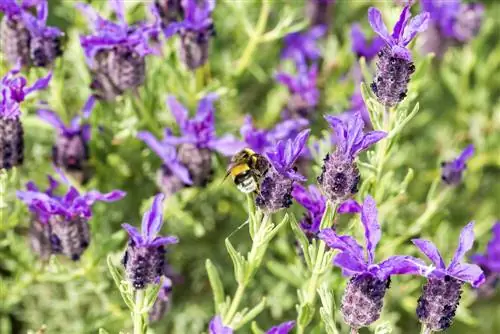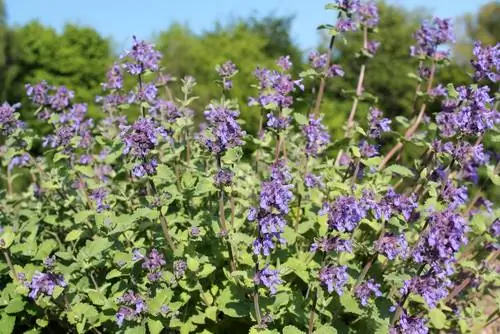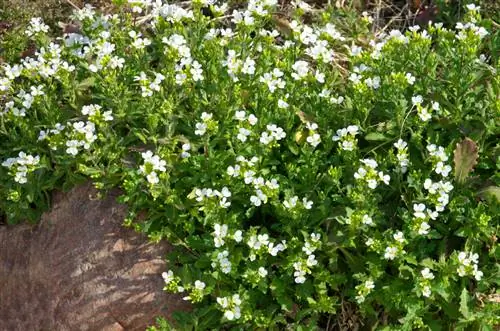- Author admin [email protected].
- Public 2024-01-10 23:11.
- Last modified 2025-01-23 11:22.
As an ornamental, medicinal and herbal plant, holy herb is on a par with tried and tested classics such as sage or lavender. Although the evergreen subshrub with bright yellow flowers comes from the Mediterranean region, it thrives here as a hardy perennial. The following answers to frequently asked questions reveal how effortless the cypress herb is to plant and care for.

How to care for saintwort in the garden?
Sacred herb, also known as cypress herb, is an ornamental, medicinal and herbal plant. It prefers sunny locations with well-drained, sandy-loamy soil. Care includes moderate watering, organic fertilizer and regular pruning to promote compact growth.
Planting holy herbs correctly
Spring is considered the ideal planting time for the Mediterranean perennial. In a sunny location with sandy-loamy and well-drained soil, create a small pit with 1.5 times the diameter of the root ball. Do not plant the potted young plant any deeper than it was previously in the nursery pot. After you have watered the holy herb, it gratefully accepts an inorganic mulch layer of gravel or grit.
Care tips
With this compact care program, young holy herb is transformed in no time into a fragrant, magnificently flowering powerhouse for the gravel bed, the roof garden and all sunny, lean and chalky areas of your garden:
- Do not water the cypress herb until the soil has dried thoroughly
- Fertilize organically as a bedding plant in April and June
- In the pot, fertilize liquidly every 14 days until the end of the flowering period
- Harvest regularly to promote compact growth
- Prune by two thirds after flowering or in late winter
In rough locations and in pot cultivation, light winter protection has a beneficial effect on maintaining he alth. A layer of brushwood or leaves in the bed keeps frosty temperatures at bay. Pots are given a winter coat made of jute or foil and are placed on wood.
Which location is suitable?
Native to the sun-drenched regions of the Mediterranean, holy herb prefers a location with these conditions:
- Sunny, warm and protected from the wind
- Ideally under an eave as protection from the rain
- Well-drained, sandy-loamy soil
The Mediterranean plant feels at home in the pot garden on the sun-drenched balcony and at the same time keeps annoying mosquitoes at bay with its scent.
What soil does the plant need?
Mediterranean saint herb feels at home in sandy-loamy, moderately dry rock garden soil. Common garden soil should be thinned out with fine grit and sand to meet the requirements. As a potting substrate, we recommend commercial herb soil, optimized with lava granules or perlite.
When is flowering time?
Bright yellow basket flowers catch the eye from June to August. The further the flowering period progresses, the more intensively saint herb exudes a pleasant, spicy scent. When the cypress herb is in full bloom, it is the best time to cut it as a dried flower.
Cut holy herbs correctly
Professional cutting plays a key role in the care program. The scissors are used in multiple ways, as the following overview shows:
- Cut fully bloomed stems close to the ground for use as dried flowers
- Cut off leaves regularly as they grow to use as a culinary, tea or medicinal herb
- In May, repeatedly prune young shoots to create bushy branching
- Cut head cuttings in June for vegetative propagation
After flowering, cut saintwort back by up to two thirds. If seeding is desired in the bed, wait until early spring before pruning.read more
Watering holy herbs
With the watering can in your hand, you will rarely set out to plant your holy herb in the garden. Experience has shown that rain covers the needs of bedding plants. However, if cultivated in a pot, the substrate dries more quickly. Therefore, check the moisture content with your finger every 2-3 days. If the soil feels dry to a depth of 2 cm, water it.
Fertilize holy herbs properly
If cypress herb thrives as a container plant, fertilize it every 14 days from April to September with a liquid preparation. Planted saintwort is satisfied with an organic starter fertilization in April, which is repeated in June. If the Mediterranean plant is not only used for decoration, but also functions as a medicinal and herbal plant, we recommend using only organic fertilizer. In the bed these are compost and horn shavings. In the pot, preparations such as BioTrissol herbal fertilizer (€8.00 at Amazon) from Neudorff meet the requirements.
Wintering
Well-established plants can tolerate frosty temperatures down to -18 degrees Celsius. In the first two years, in harsh winter locations and in pot cultivation, we still recommend the following precautions:
- Cover holy herb in the bed before the first frost with leaves, brushwood or pine fronds
- Place large pots on wood in front of the south wall of the house and wrap them with foil
- Pots with a diameter of less than 30 cm should ideally be placed in bright, frost-free winter quarters
Since cypress herb grows evergreen, continue to water the plant so that the root ball does not dry out.
Propagate holy herbs
If gardening enthusiasts are looking for more specimens, holy herb offers three propagation methods. Division in spring can be done even by an inexperienced hand. Simply dig up the root ball, divide it and plant it in the ground at the new location. In early summer, the plant produces an abundance of top cuttings, which are grown into magnificent young plants in a pot with a lean substrate. Anyone looking for a gardening challenge decides to sow seeds. Since you are dealing with cold germs, stratification lasting several weeks is necessary.
Holy herb in a pot
In order to always have holy herb at hand for the kitchen, there is nothing wrong with cultivating it in a pot on the sunny windowsill. A commercially available herbal soil can be used as a substrate, enriched with a little sand for best permeability. A piece of clay over the water drain also prevents harmful waterlogging. Care in the pot is short and sweet. Only water when the substrate has dried. From May to September, apply a liquid fertilizer in a diluted concentration weekly. After the flowering period has ended, carefully cut the plant into shape. The cypress herb stays bright and cool throughout the winter to gather strength for the next season.
Is holy herb poisonous?
Sacred herb is full of valuable ingredients such as essential oils, tannins and bitter substances. Since ancient times, saint herb in particular has made a name for itself as an effective medicinal plant. In the 17th century, the cypress herb was discovered as a spicy ingredient for delicious dishes and is still considered an insider tip among gourmets today. There is no trace of poison in this plant anywhere.
What possible uses are there?
The pretty yellow flowers are by no means the only motivation for growing saint herb. The valuable ingredients qualify the plant for these multi-faceted uses:
- As a spicy accompaniment to fresh and cooked dishes
- Fresh or dried leaves prepared into an aromatic tea
- Soothing for colds, stomach and intestinal problems
- Dried flowers as table decorations throughout the year
- Fresh flowers as a repellent for mosquitoes
- Dried flowers in a bag as a moth control agent
Shortly before the flowering period begins, the content of the ingredients is at its peak. During and after flowering, the scent remains, although the taste of the leaves and seeds takes on a sharp, bitter note.read more






